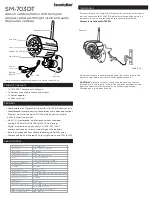
8
OPAL Pro
SATEL
5. Fasten the electronics module in the enclosure base.
6. Connect the wires to the corresponding terminals.
If the detector is to be installed outdoors, do not connect the anti-mask outputs to the
control panel zones. Severe weather conditions, including rain, fog or frost, can be
interpreted by the anti-mask circuit as an attempt to mask the detector.
7. Power-up the detector. All the LEDs will be blinking alternately for 40 seconds, signaling
the detector warm-up.
8. After the LEDs stop blinking, configure the detector (
see: “Configuring the detector”).
9. Replace the cover.
10. Power-off the detector and then power-up it again for the anti-mask circuit to configure
properly. After power-up, the detector will be analyzing (for 40 seconds) the environment
in which it has been installed, and will adapt the operating parameters of anti-mask
accordingly. When the environment analysis is in progress, the enclosure must be closed
and the detector must not be covered by any undesirable objects.
Wall mounting
1. Run the cable through the opening in the enclosure base.
2. Using wall plugs (screw anchors) and screws, fasten the enclosure base to the wall
Angle bracket mounting
1. Attach extra tamper switch:
– screw the holder to the tamper switch (Fig. 7-I),
– screw the tamper unit to the enclosure base (Fig. 7-III).
Figure 7 shows mounting the tamper switch in one of two available positions.
The place of tamper switch installing depends on the way of angle bracket mounting.
If the tamper switch is to be installed in the other position, place tamper switch holder
on the other side.
2. Prepare openings in the bracket for screws and a cable.
3. Pass the cable through the prepared opening.
4. Using wall plugs (screw anchors) and screws, fasten the bracket to the wall.
5. Run the cable through the opening in the enclosure base.
6. Using screws, fasten the enclosure base to the bracket (Fig. 7-IV).
Содержание OPAL Pro
Страница 12: ...10 OPAL Pro SATEL...


































